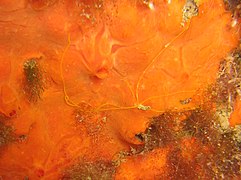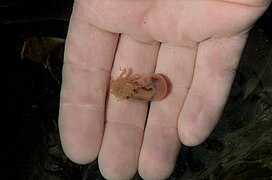Terebellidae
| Terebellidae | |
|---|---|

| |
| Lanice conchilega (), taken out of its burrow. Note "spaghetti" tentacles on head. | |
| Scientific classification | |
| Kingdom: | Animalia |
| Phylum: | Annelida |
| Class: | Polychaeta |
| Order: | Terebellida |
| Suborder: | Terebellomorpha |
| Family: | Terebellidae Grube, 1851 |
| Subfamilies | |
|
4, see text | |
The Terebellidae is a marine family of polychaete worms, of which the type taxon is Terebella, described by Carl Linnaeus in his 1767 12th edition of Systema Naturae.[1]
Characteristics[]
Most terebellids live in burrows or crevices and are often of large size, ranging up to 150 millimetres in length and 15 millimetres in width. The numerous, very long tentacles which radiate from near the mouth are used for finding and collecting food particles from the sediment surface. The tentacles are not retractable as is the case in the ampharetids. They have plump anterior bodies and numerous segments in their long, tapered posterior bodies, whereas ampharetids are more compact. They have branched gills laterally on up to three anterior chaetigers but in the subfamily the gills are numerous simple filaments. The mid-body chaetigers are in double rows in the subfamily . In the subfamily , the gills are absent and the prostomium is expanded as an undulating membrane which bears the tentacles.,[2][3]
Systematics[]
The roughly 400 known species are divided between many dozens of genera. Most of these are assigned to 4 subfamilies.[4] Some additional genera are of unresolved or quite basal position.
- subfamily Malmgren, 1867
- genus Hartman, 1959
- genus Biremis Polloni, Rowe & Teal, 1973
- genus Verrill, 1879
- genus Hauchiella Levinsen, 1893
- genus Malmgren, 1866
- genus Grube, 1850
- subfamily Malmgren, 1867
- genus Amphitrite O.F. Müller, 1771
- genus Augener, 1922
- genus Hutchings & Glasby, 1988
- genus Malmgren, 1866
- genus Nogueira, Hutchings & Amaral, 2003
- genus Malmgren, 1866
- genus Wesenberg-Lund, 1950
- genus Saint-Joseph, 1894
- genus Banse, 1980
- genus Peters, 1855
- genus Chamberlin, 1919
- genus Eupolymnia Verrill, 1900
- genus Hutchings, 1977
- genus Londono-Mesa, 2003
- genus Lanassa Malmgren, 1866
- genus Lanice Malmgren, 1866
- genus Hessle, 1917
- genus Hartmann-Schröder, 1986
- genus Malmgren, 1866
- genus Malmgren, 1866
- genus Loimia Malmgren, 1865
- genus Hutchings & Murray, 1984
- genus Nogueira & Amaral, 2001
- genus Neoamphitrite Hessle, 1917
- genus Hessle, 1917
- genus Malmgren, 1866
- genus Caullery, 1944
- genus Caullery, 1944
- genus Holthe, 1976
- genus Fauchald, 1972
- genus Saint-Joseph, 1894
- genus Pista Malmgren, 1866
- genus Hartmann-Schröder, 1996
- genus Verrill, 1900
- genus Saint-Joseph, 1894
- genus Hutchings & Smith, 1997
- genus Hutchings & Glasby, 1990
- genus Hartman, 1944
- genus Hartman, 1963
- genus Moore, 1903
- genus Chamberlin, 1919
- genus Hessle, 1917
- genus Uchida, 1968
- genus Levenstein, 1957
- genus Terebella Linnaeus, 1767
- genus Hartmann-Schröder, 1962
- genus Day, 1951
- genus Hutchings, 1997
- subfamily Hessle, 1917
- genus Hutchings, 1977
- genus McIntosh, 1885
- genus Hutchings & Glasby, 1986
- genus Caullery, 1915
- genus Hartmann-Schröder, 1960
- genus Hutchings & Murray, 1984
- genus Augener, 1918
- genus Hutchings, 1974
- genus Sars, 1872
- genus Day, 1955
- genus Gravier, 1911
- genus Thelepus Leuckart, 1849
Gallery[]

Amphitrite sp.

sp.
See also[]
References[]
- ^ WoRMS taxon register.
- ^ Annelid resources
- ^ http://www.marinespecies.org/aphia.php?p=taxdetails&id=322588 accessed 23 September 2013
- ^ World Register of Marine Species
External links[]
| Wikispecies has information related to Terebellidae. |
| Wikimedia Commons has media related to Terebellidae. |
- Terebellida




